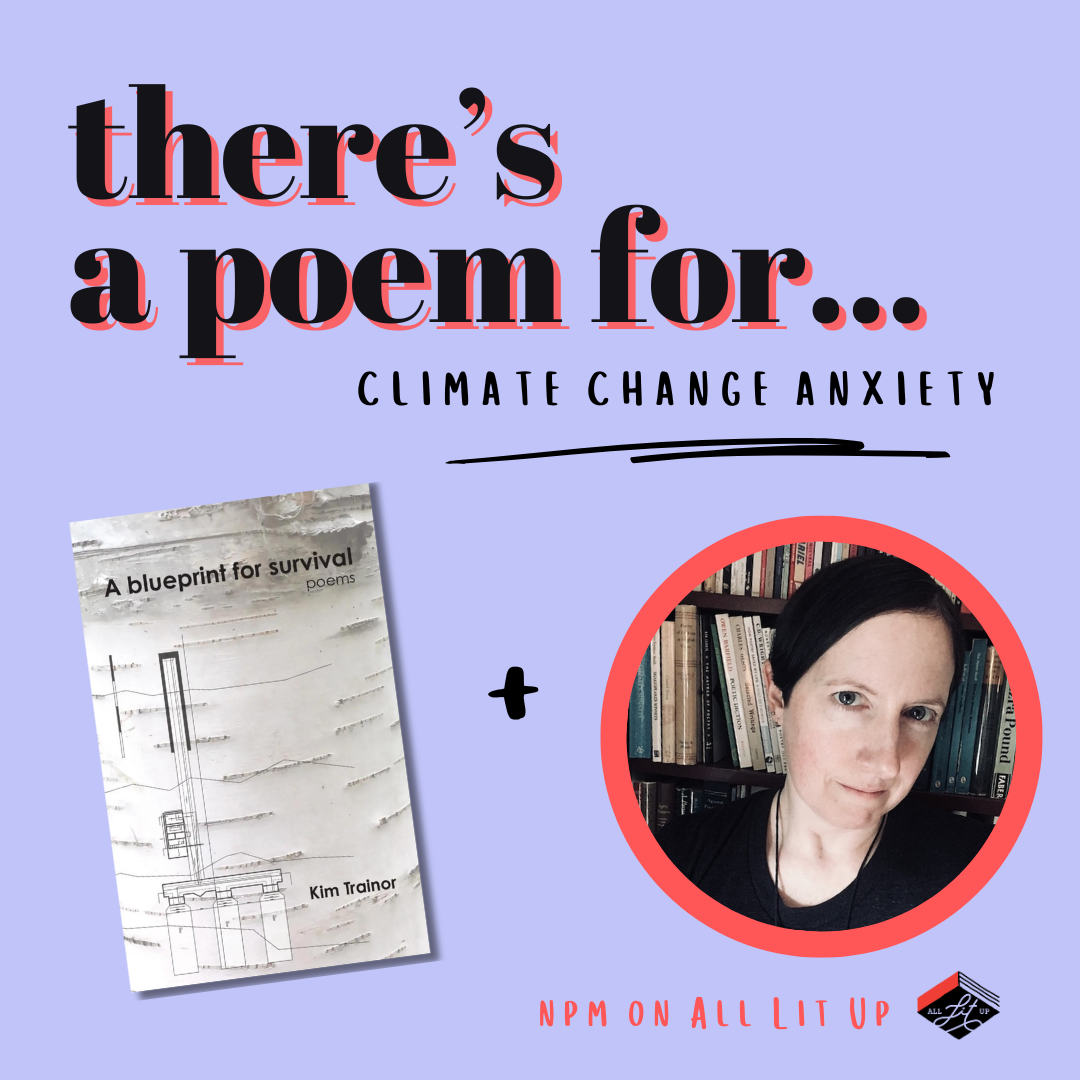Your cart is currently empty!
There’s a Poem for That: Kim Trainor + A blueprint for survival
Plesiosaurs and seed banks, ecological data and sacred sites form the inspiration for Kim Trainor’s latest collection of poetry, A blueprint for survival (Guernica Editions). We talk to Kim about the fragility of our ecosystem and read “Little Mountain” from the collection.


An interview with poet Kim Trainor
All Lit Up: Can you tell us a bit about A blueprint for survival and how it came to be?

Kim Trainor: A blueprint for survival began in Edmonton, Alberta. I was visiting my partner at the time who had moved there to research climate change in the boreal. Afternoons I would go to the Centre for Interdisciplinary Science at the University of Alberta and work in the giant foyer beneath the articulated plesiosaur skeleton that hangs from the ceiling. I was there during a polar vortex, and again in the summer when the skies were thick with wildfire ash from forest fires in BC. I began to think about the trajectory of our planet, so precipitously in decline since I was born in 1970. I began to write ‘Seeds,’ thinking of each poem or seed –the Common raven, the idea of a seedbank and a codex, Vespa orientalis, which can manufacture energy from sunlight—as a blueprint for modeling different ways of surviving and being in the world. The title is drawn from this old Penguin paperback edition of The Ecologist’s issue of the same name that came out in 1972 and was warning even then of the dangers of climate change and species extinction.
ALU: What has been your most unlikely source of writing inspiration?
Kim Trainor: Perhaps the Svalbard seedbank. I’ve always loved poems that focus on practical, domestic, common, artefacts, like Eavan Boland’s poems about cloth and penicillin.
ALU: What are you most in the mood to read these days? Any poets you’re especially enjoying?
Kim Trainor: I can only focus on theory and philosophy just now–at the moment, I’m reading Iain McGilchrist’s The Matter with Things.
ALU: What did you learn while writing your collection?
Kim Trainor: Writing this collection, in combination with my time spent at Ada’tisx / Fairy Creek over the past few years, has changed the focus of my poetry. I’ve become deeply interested in the intersection of lyric poetry and ecology, in how lyric poetry might be a conduit for considering other ways of being in the world, for approaching, if obliquely, the ‘thing in itself,’ for recognizing the alterity of others. And I’ve become intrigued by the idea of how a lyric poem might translate or interpret ecological data – poems like Miebach sculptures.
ALU: If you were to set your collection to a soundtrack, what song is at the top of the listing?
Kim Trainor: I’ve been collaborating with composer and musician Hazel Fairbairn on creating tiny poetry films based on the ‘Seeds’ in part 2 of this collection. She creates beautiful, sometimes haunting soundtracks, incorporating biosonification (data captured from plant organisms and filtered through a MIDI board), recordings of naturally occurring sounds, and melodies from her own training in Celtic fiddle music. These soundscapes – for ‘Lentil,’ ‘Common raven,’ ‘The Beautiful Cell’ – are the soundtrack for A blueprint for survival. The score Hazel created for ‘Tardigrade’ would be top of the list, for its ethereal mix of sounds created from scanned images, morse code, and fiddle.
There’s a poem for climate change anxiety…
“Little Mountain” from A blueprint for survival
In your version of God testing himself in the void, the scattered
parts sometimes join together—fungus and algae sharing a skin,
roots and mycelia intertwined below ground, lovers sharing a bed.
We spread a blanket in the shade of little mountain. Dried
leaves, prickles. Spiders pick their way across woven cotton.
Wildfire smoke has returned. The sky is pink ash.
A man called Isaac searches for holy sparks in the Galilee.
We lie together on this last day of summer and talk
alchemy, Genesis, the blue graves of Safed.
It is better that God is shattered. Glints. Dew in grass.
* * *

Kim Trainor is the granddaughter of an Irish banjo player and a Polish faller who worked in logging camps around Port Alberni in the 1930s. Her earlier books are Karyotype (Brick Books, 2015), Ledi (Book*hug, 2018), shortlisted for the Raymond Souster award, and A thin fire runs through me (icehouse poetry / Goose Lane Editions, 2023). Her poems have appeared in Anthropocenes (AHIP), Ecocene, ISLE, Ecozon@, Dark Mountain (UK) and Fire Season I and II (Vancouver). Her poetry films have screened at Zebra Poetry Film Festival (Berlin) and at +the Institute [for experimental art] (Athens), as well as in Dublin and Seattle. Her current project is “walk quietly / ts’ekw’unshun kws qututhun,” a guided walk at Hwlhits’um (Canoe Pass) in Delta, BC, featuring contributions from artists, scientists, and Hwlitsum and Cowichan knowledge holders.
* * *
Thanks to Kim Trainor for answering our questions, and to Guernica Editions for the text of “Little Mountain” from A Blueprint for Survival, which is available to order now (and get 15% off with the code THERESAPROMO4THAT until April 30!).
For more poetry month, catch up on our “there’s a poem for that” series here, and visit our poetry shop here.




